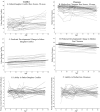Development and Lability in the Parent-Child Relationship During Adolescence: Associations With Pubertal Timing and Tempo
- PMID: 26321856
- PMCID: PMC4550307
- DOI: 10.1111/jora.12139
Development and Lability in the Parent-Child Relationship During Adolescence: Associations With Pubertal Timing and Tempo
Abstract
Adolescents' and parents' reactions to pubertal development are hypothesized to contribute to changes in family dynamics. Using 7-year longitudinal data from the NICHD-SECCYD (488 boys, 475 girls) we examined relations between pubertal development (timing, tempo) and trajectories (developmental change and year-to-year lability) of parent-child conflict and closeness from age 8.5 to 15.5 years. Changes were mostly characterized by year-to-year fluctuations - lability. Parent-child conflict increased and closeness decreased some with age. Pubertal timing and tempo were more consistently associated with lability in parent-child relationships than with long-term trends, although faster tempo was associated with steeper decreases in parent-child closeness. Findings provide a platform for examining how puberty contributes to both long-term and transient changes in adolescents' relationships and adjustment.
Keywords: Father-child; Lability; Longitudinal; Mother-child; Puberty.
Figures




Similar articles
-
Longitudinal associations between parent-child relationships in middle childhood and child-perceived loneliness.J Fam Psychol. 2018 Sep;32(6):841-847. doi: 10.1037/fam0000446. Epub 2018 Jul 23. J Fam Psychol. 2018. PMID: 30035574
-
Trajectories of mother-child and father-child relationships across middle childhood and associations with depressive symptoms.Dev Psychopathol. 2019 Oct;31(4):1381-1393. doi: 10.1017/S0954579418000809. Dev Psychopathol. 2019. PMID: 30556510
-
Longitudinal Associations of Pubertal Timing and Tempo With Adolescent Mental Health and Risk Behavior Initiation in Urban South Africa.J Adolesc Health. 2021 Jul;69(1):64-73. doi: 10.1016/j.jadohealth.2020.09.043. Epub 2021 Jan 9. J Adolesc Health. 2021. PMID: 33431244 Free PMC article.
-
The tempo of puberty and its relationship to adolescent health and well-being: A systematic review.Acta Paediatr. 2020 May;109(5):900-913. doi: 10.1111/apa.15092. Epub 2019 Dec 11. Acta Paediatr. 2020. PMID: 31730292
-
Do parent-child relationships change during puberty?Psychol Bull. 1991 Jul;110(1):47-66. doi: 10.1037/0033-2909.110.1.47. Psychol Bull. 1991. PMID: 1891518 Review.
Cited by
-
Becoming a Teenager after Early Surgical Ventricular Septal Defect (VSD) Repair: Longitudinal Biopsychological Data on Mental Health and Maternal Involvement.J Clin Med. 2022 Dec 6;11(23):7242. doi: 10.3390/jcm11237242. J Clin Med. 2022. PMID: 36498814 Free PMC article.
-
Child Effects on Lability in Parental Warmth and Hostility: Moderation by Parents' Internalizing Problems.J Youth Adolesc. 2019 May;48(5):963-978. doi: 10.1007/s10964-019-00983-7. Epub 2019 Feb 11. J Youth Adolesc. 2019. PMID: 30747356 Free PMC article.
-
Pubertal Maturation Compression and Behavioral Impulsivity among Boys at Increased Risk for Substance Use.Addict Disord Their Treat. 2016 Jun;15(2):61-73. doi: 10.1097/ADT.0000000000000077. Addict Disord Their Treat. 2016. PMID: 27199616 Free PMC article.
-
Differential sensitization of parenting on early adolescent cortisol: Moderation by profiles of maternal stress.Psychoneuroendocrinology. 2016 May;67:18-26. doi: 10.1016/j.psyneuen.2016.01.025. Epub 2016 Feb 1. Psychoneuroendocrinology. 2016. PMID: 26859701 Free PMC article.
-
Development of Father- and Mother-Child Intimacy and Their Association with Internalizing and Externalizing Problems among Early and Middle Chinese Adolescents.J Youth Adolesc. 2025 May;54(5):1326-1339. doi: 10.1007/s10964-025-02139-2. Epub 2025 Jan 18. J Youth Adolesc. 2025. PMID: 39827335
References
-
- Anderson ER, Hetherington EM, Clingempeel WG. Transformations in family relations at puberty: Effects of family context. Journal of Early Adolescence. 1989;9(3):310–334.
-
- Aquilino WS. From adolescent to young adult: A prospective study of parent-child relations during the transition to adulthood. Journal of Marriage and the Family. 1997;59:670–686.
-
- Belsky J, Steinberg L, Draper P. Childhood Experience, Interpersonal Development, and Reproductive Strategy: An Evolutionary Theory of Socialization. Child Development. 1991;62(4):647–670. - PubMed
-
- Belsky J, Steinberg L, Houts RM, Halpern-Felsher BL. The development of reproductive strategy in females: Early maternal harshness → earlier menarche → increased sexual risk taking. Developmental Psychology. 2010;46:120–128. - PubMed
-
- Biro FM, McMahon RP, Striegel-Moore R, Crawford PB, Obarzanek E, Morrison JA, et al. Falkner F. Impact of timing of pubertal maturation on growth in Black and White female adolescents: The National Heart, Lung, and Blood Institute Growth and Health Study. Journal of Pediatrics. 2001;138:636–643. doi: 10.1067/mpd.2001.114476. - DOI - PubMed
Grants and funding
- U10 HD025420/HD/NICHD NIH HHS/United States
- U01 HD033343/HD/NICHD NIH HHS/United States
- U10 HD025430/HD/NICHD NIH HHS/United States
- U10 HD025447/HD/NICHD NIH HHS/United States
- U10 HD025451/HD/NICHD NIH HHS/United States
- U10 HD025455/HD/NICHD NIH HHS/United States
- RC1 AG035645/AG/NIA NIH HHS/United States
- T32 DA016184/DA/NIDA NIH HHS/United States
- F31 DA033737/DA/NIDA NIH HHS/United States
- U10 HD025456/HD/NICHD NIH HHS/United States
- U10 HD027040/HD/NICHD NIH HHS/United States
- U10 HD025449/HD/NICHD NIH HHS/United States
- U10 HD025445/HD/NICHD NIH HHS/United States
- U10 HD025460/HD/NICHD NIH HHS/United States
LinkOut - more resources
Full Text Sources
Other Literature Sources
